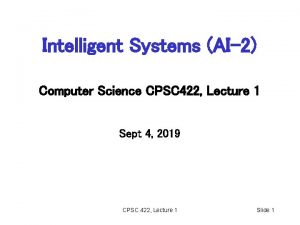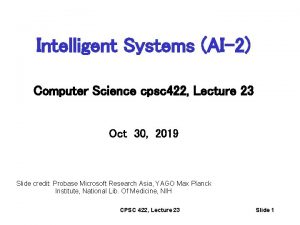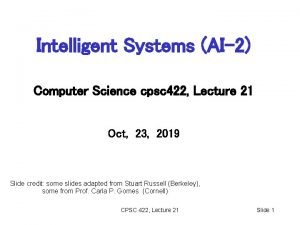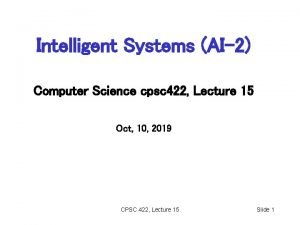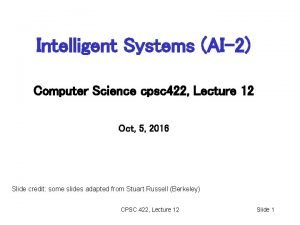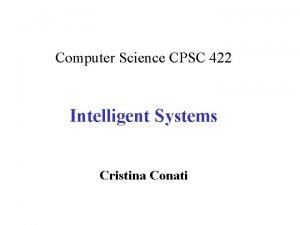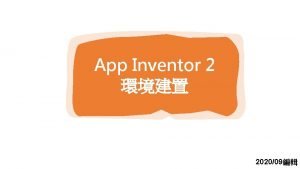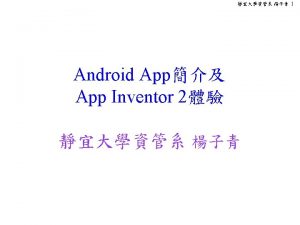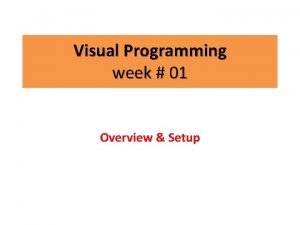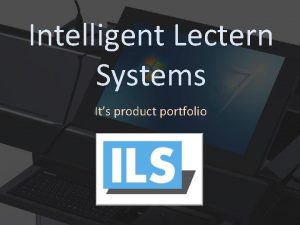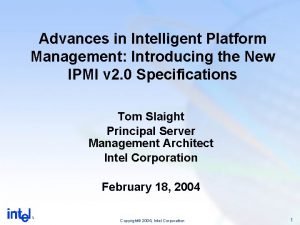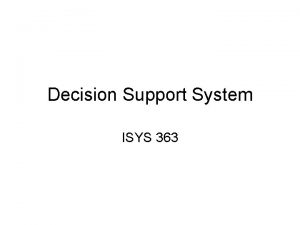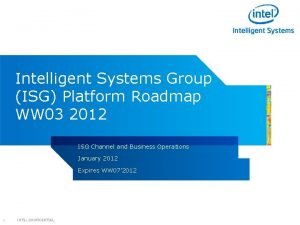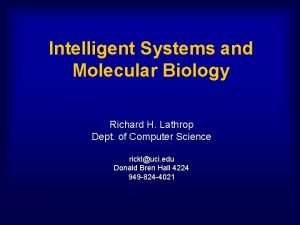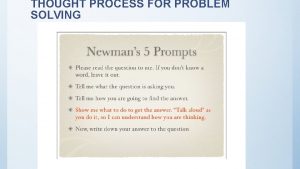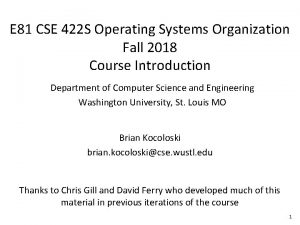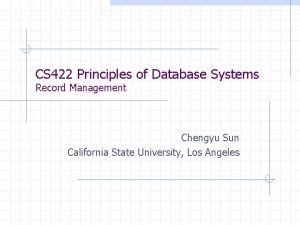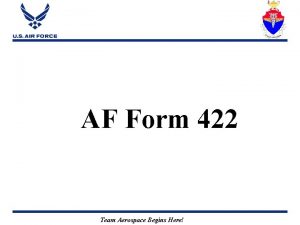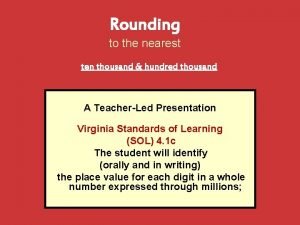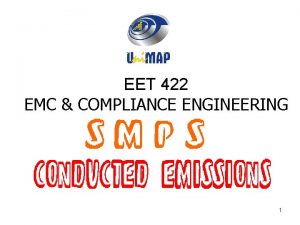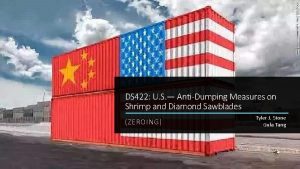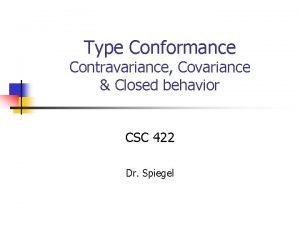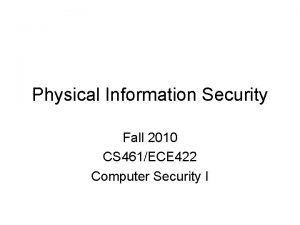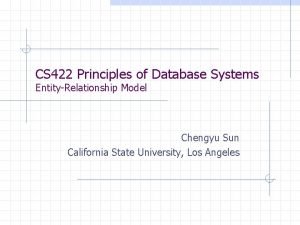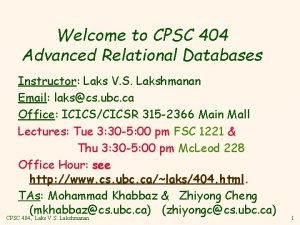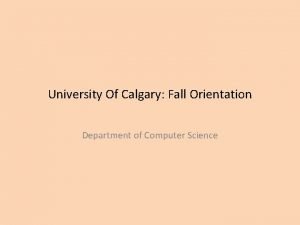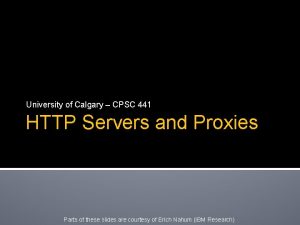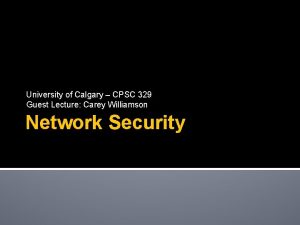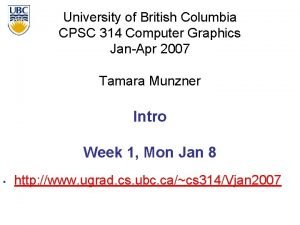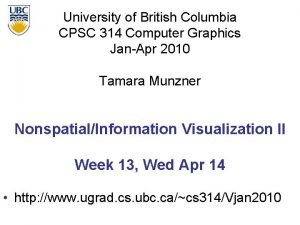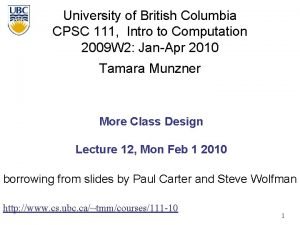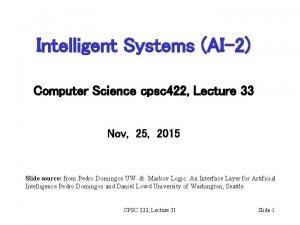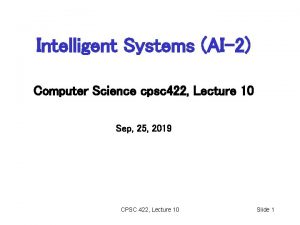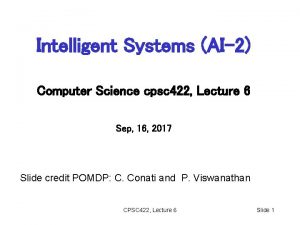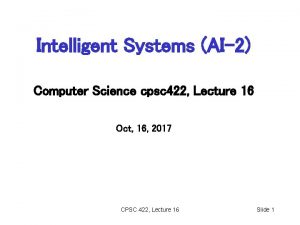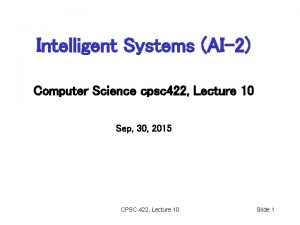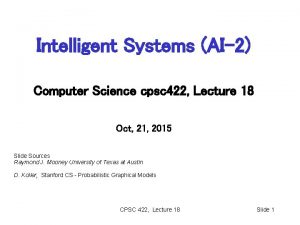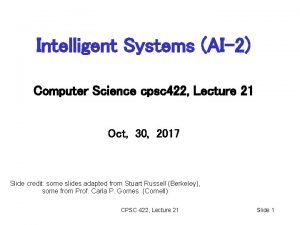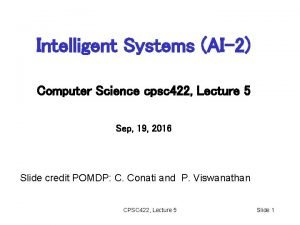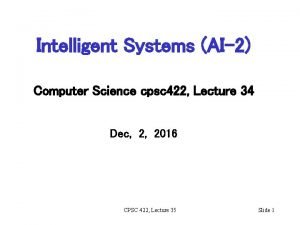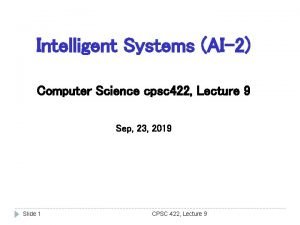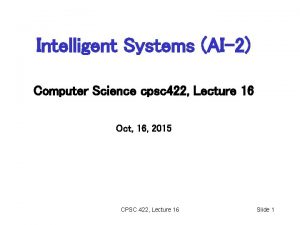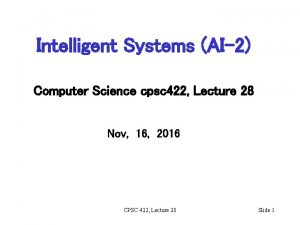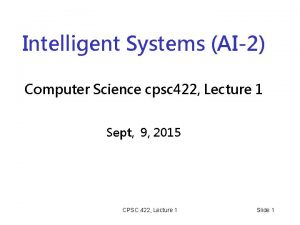Intelligent Systems AI2 Computer Science cpsc 422 Lecture
































![Fast Changing Landscape…. From Probase page. . . [Sept. 2016] Please visit our Microsoft Fast Changing Landscape…. From Probase page. . . [Sept. 2016] Please visit our Microsoft](https://slidetodoc.com/presentation_image/75535956b2630616da6522df411378a3/image-33.jpg)










- Slides: 43

Intelligent Systems (AI-2) Computer Science cpsc 422, Lecture 23 Nov 3, 2017 Slide credit: Probase Microsoft Research Asia, YAGO Max Planck Institute, National Lib. Of Medicine, NIH CPSC 422, Lecture 23 Slide 1

NLP Practical Goal for FOL: the ultimate Web question-answering system? Map NL queries into FOPC so that answers can be effectively computed What African countries are not on the Mediterranean Sea? • Was 2007 the first El Nino year after 2001? CPSC 422, Lecture 22 2

Just a sketch: to provide some context for some concepts / techniques cobvered in 422 CPSC 422, Lecture 23 Slide 3

Logics in AI: Similar slide to the one for planning Propositional Definite Clause Logics Propositional Logics Semantics and Proof Theory Satisfiability Testing (SAT) First-Order Logics Production Systems Ontologies Product Configuration Cognitive Architectures Semantic Web Video Games Summarization Information Extraction Hardware Verification Tutoring Systems CPSC 422, Lecture 21 Slide 4

Lecture Overview • Ontologies – what objects/individuals should we represent? what relations (unary, binary, . . )? • Inspiration from Natural Language: Word. Net and Frame. Net • Extensions based on Wikipedia and mining the Web (YAGO, Pro. Base, Freebase) • Domain Specific Ontologies (e. g. , Medicine: Me. SH, UMLS) CPSC 422, Lecture 23 5

Ontologies Given a logical representation (e. g. , FOL) What individuals and relations are there and we need to model? In AI an Ontology is a specification of what individuals and relationships are assumed to exist and what terminology is used for them • What types of individuals • What properties of the individuals CPSC 422, Lecture 23 Slide 6

Ontologies: inspiration from Natural Language : How do we refer to individuals and relationship in the world in Natural Languages e. g. , English? Where do we find definitions for words? Most of the definitions are circular? They are descriptions. Fortunately, there is still some useful semantic info (Lexical Relations): w 1 w 1 w 2 same Form and Sound, different Meaning Homonymy w 2 same Meaning, different Form Synonymy w 2 “opposite” Meaning Antonymy w 2 Meaning 1 subclass of Meaning 2 Hyponymy CPSC 422, Lecture 23 7

Polysemy Def. The case where we have a set of words with the same form and multiple related meanings. Consider the homonym: bank commercial bank 1 vs. river bank 2 • Now consider: “VGH is the hospital with the largest blood bank in BC” or • “A PCFG can be trained using derivation trees from a tree bank annotated by human experts” • Are these a new independent senses of bank? CPSC 422, Lecture 23 8

Synonyms Def. Different words with the same meaning. Substitutability- if they can be substituted for one another in some environment without changing meaning or acceptability. Would I be flying on a large/big plane? ? … became kind of a large/big sister to… ? You made a large/big mistake CPSC 422, Lecture 23 9

Hyponymy/Hypernym Def. Pairings where one word denotes a sub/super class of the other • Since dogs are canids üDog is a hyponym of canid and üCanid is a hypernym of dog car/vehicle doctor/human …… CPSC 422, Lecture 23 10

Lexical Resources Databases containing all lexical relations among all words • Development: – Mining info from dictionaries and thesauri – Handcrafting it from scratch • Word. Net: first developed with reasonable coverage and widely used, started with [Fellbaum… 1998] – for English (versions for other languages have been developed – see Multi. Word. Net) CPSC 422, Lecture 23 11

Part Of Speech Noun Verb Adjective Adverb Totals Unique Strings Word. Net 3. 0 Word-Sense Pairs Synsets 117798 11529 146312 25047 82115 13767 21479 4481 30002 5580 18156 3621 155287 206941 117659 • For each word: all possible senses (no distinction between homonymy and polysemy) • For each sense: a set of synonyms (synset) and a gloss CPSC 422, Lecture 23 12

Word. Net: entry for “table” The noun "table" has 6 senses in Word. Net. 1. table, tabular array -- (a set of data …) 2. table -- (a piece of furniture …) 3. table -- (a piece of furniture with tableware…) 4. mesa, table -- (flat tableland …) 5. table -- (a company of people …) 6. board, table -- (food or meals …) The verb "table" has 1 sense in Word. Net. 1. postpone, prorogue, hold over, put over, table, shelve, set back, defer, remit, put off – (hold back to a later time; "let's postpone the exam") CPSC 422, Lecture 23 13

Word. Net Relations (between synsets!) fi CPSC 422, Lecture 23 14

Visualizing Wordnet Relations C. Collins, “Word. Net Explorer: Applying visualization principles to lexical semantics, ” University of Toronto, Technical Report kmdi 2007 -2, 2007. CPSC 422, Lecture 24 Slide 15

Word. Net Hierarchies: “Vancouver” Word. Net: example from ver 1. 7. 1 For the three senses of “Vancouver” (city, metropolis, urban center) (municipality) (urban area) (geographical area) (region) (location) (entity, physical thing) (administrative district, territorial division) (district, territory) (region) (location (entity, physical thing) (port) (geographic point) (location) CPSC 422, Lecture 23 (entity, physical thing) 16

Web interface & API CPSC 422, Lecture 23 Slide 17

Wordnet: NLP Tasks • First success in “obscure” task for Probabilistic Parsing (PP-attachments): words + word-classes extracted from the hypernym hierarchy increase accuracy from 84% to 88% [Stetina and Nagao, 1997] • Word sense disambiguation • Lexical Chains (summarization) • …… and many others ! More importantly starting point for larger Ontologies! CPSC 422, Lecture 23 18

More ideas from NLP…. Relations among words and their meanings (paradigmatic) Internal structure of individual words (syntagmatic) CPSC 422, Lecture 23 19

Predicate-Argument Structure • Represent relationships among concepts, events and their participants “I ate a turkey sandwich for lunch” $ w: Isa(w, Eating) Ù Eater(w, Speaker) Ù Eaten(w, Turkey. Sandwich) Ù Meal. Eaten(w, Lunch) “Nam does not serve meat” $ w: Isa(w, Serving) Ù Server(w, Nam) Ù Served(w, Meat) CPSC 422, Lecture 23 20

Semantic Roles: Resources • Move beyond inferences about single verbs “ IBM hired John as a CEO ” “ John is the new IBM hire ” “ IBM signed John for 2 M$” • Frame. Net: Databases containing frames and their syntactic and semantic argument structures • (book online Version 1. 5 -update Sept, 2010) – for English (versions for other languages are under development) • Frame. Net Tutorial at NAACL/HLT 2015! CPSC 422, Lecture 23 21

Frame. Net Entry Hiring • Definition: An Employer hires an Employee, promising the Employee a certain Compensation in exchange for the performance of a job. The job may be described either in terms of a Task or a Position in a Field. • Inherits From: Intentionally affect • Lexical Units: commission. n, commission. v, give job. v, hire. n, hire. v, retain. v, sign. v, take on. v CPSC 422, Lecture 23 22

Frame. Net : Semantic Role Labeling Some roles. . Employer Employee Task Position • np-vpto – In 1979 , singer Nancy Wilson HIRED him to open her nightclub act. – …. • np-ppas – Castro has swallowed his doubts and HIRED Valenzuela as a cook in his small restaurant. CPSC 422, Lecture 23 23

Lecture Overview • Ontologies – what objects/individuals should we represent? what relations (unary, binary, . . )? • Inspiration from Natural Language: Word. Net and Frame. Net • Extensions based on Wikipedia and mining the Web & Web search logs (YAGO, Pro. Base, Freebase, ……) • Domain Specific Ontologies (e. g. , Medicine: Me. SH, UMLS) CPSC 422, Lecture 23 24

YAGO 2: huge semantic knowledge base Derived from Wikipedia, Word. Net and Geo. Names. (started in 2007, paper in www conference) 106 entities (persons, organizations, cities, etc. ) >120* 106 facts about these entities. • YAGO accuracy of 95%. has been manually evaluated. • Anchored in time and space. YAGO attaches a temporal dimension and a spatial dimension to many of its facts and entities. CPSC 422, Lecture 23 25

Freebase • • • “Collaboratively constructed database. ” Freebase contains tens of millions of topics, thousands of types, and tens of thousands of properties and over a billion of facts Automatically extracted from a number of resources including Wikipedia, Music. Brainz, and NNDB as well as the knowledge contributed by the human volunteers. Each Freebase entity is assigned a set of humanreadable unique keys, which are assembled of a value and a namespace. All was available for free through the APIs or to download from weekly data dumps CPSC 422, Lecture 23 Slide 26

Fast Changing Landscape. . . On 16 December 2015, Google officially announced the Knowledge Graph API, which is meant to be a replacement to the Freebase API. Freebase. com was officially shut down on 2 May 2016. [6] CPSC 422, Lecture 23 Slide 27

Probase (MS Research) < Sept 2016 • Harnessed from billions of web pages and years worth of search logs • Extremely large concept/category space (2. 7 million categories). • Probabilistic model for correctness, typicality (e. g. , between concept and instance) CPSC 422, Lecture 23 Slide 28

CPSC 422, Lecture 23 Slide 29

A snippet of Probase's core taxonomy CPSC 422, Lecture 23 Slide 30

Frequency distribution of the 2. 7 million concepts The Y axis is the number of instances each concept), and on the X axis are the 2. 7 million concepts ordered by their size contains(logarithmic scale), and on the X axis are the 2. 7 million concepts ordered by their size. CPSC 422, Lecture 23 Slide 31

Frequency distribution of the 2. 7 million concepts The Y axis is the number of instances each concept contains(logarithmic scale), and on the X axis are the 2. 7 million concepts ordered by their size. besides popular concepts such as “cities” and “musicians”, which are included by almost every general purpose taxonomy, Probase has millions of long tail concepts such as “anti-parkinson treatments”, "celebrity wedding dress designers” and “basic watercolor techniques”, Slide 32 CPSC 422, Lecture 23
![Fast Changing Landscape From Probase page Sept 2016 Please visit our Microsoft Fast Changing Landscape…. From Probase page. . . [Sept. 2016] Please visit our Microsoft](https://slidetodoc.com/presentation_image/75535956b2630616da6522df411378a3/image-33.jpg)
Fast Changing Landscape…. From Probase page. . . [Sept. 2016] Please visit our Microsoft Concept Graph release for up-to-date information of this project! CPSC 422, Lecture 23 Slide 33

Interesting dimensions to compare Ontologies (but form Probase so possibly biased) CPSC 422, Lecture 23 Slide 34

Lecture Overview • Ontologies – what objects/individuals should we represent? what relations (unary, binary, . . )? • Inspiration from Natural Language: Word. Net and Frame. Net • Extensions based on Wikipedia and mining the Web (YAGO, Pro. Base, Freebase) • Domain Specific Ontologies (e. g. , Medicine: Me. SH, UMLS) CPSC 422, Lecture 23 35

Domain Specific Ontologies: UMLS, Me. SH Unified Medical Language System: brings together many health and biomedical vocabularies • Enable interoperability (linking medical terms, drug names) • Develop electronic health records, classification tools • Search engines, data mining CPSC 422, Lecture 23 Slide 36

Portion of the UMLS Semantic Net CPSC 422, Lecture 23 Slide 37

Learning Goals for today’s class You can: • Define an Ontology • Describe and Justify the information represented in Wordnet and Framenet • Describe and Justify the three dimensions for comparing ontologies CPSC 422, Lecture 23 Slide 38

Announcements: Midterm • Avg 66 Max 103! Min 14 • If score below 70 need to very seriously revise all the material covered so far • You can pick up a printout of the solutions along with your midterm BUT Before you look at the solutions try to answer the questions by yourself now that you have all the time you want and access to your notes CPSC 422, Lecture 19 39

New Re-weighting to help you Original breakdown • Assignments -- 15% • Readings: Questions and Summaries -- 10% • Midterm -- 30% • Final -- 45% BUT If your grade improves 10% from the midterm to the final • Assignments -- 15% • Readings: Questions and Summaries -- 10% • Midterm -- 15% • Final -- 60% CPSC 422, Lecture 23 40

Assignment-3 out – due Nov 20 (8 -18 hours – working in pairs on programming parts is strongly advised) Next class Mon • Similarity measures in ontologies (e. g. , Wordnet) CPSC 422, Lecture 23 41

CPSC 422, Lecture 23 42

DBpedia is a structured twin of. Wikipedia. Currently it describes more than 3. 4 million entities. DBpedia resources bear the names of the Wikipedia pages, from which they have been extracted. YAGO is an automatically created ontology, with taxonomy structure derived from Word. Net, and knowledge about individuals extracted from Wikipedia. Therefore, the identifiers of resources describing individuals in YAGO are named as the corresponding Wikipedia pages. YAGO contains knowledge about more than 2 million entities and 20 million facts about them. Freebase is a collaboratively constructed database. It contains knowledge automatically extracted from a number of resources including Wikipedia, Music. Brainz, 2 and NNDB, 3 as well as the knowledge contributed by the human volunteers. Freebase describes more than 12 million interconnected entities. Each Freebase entity is assigned a set of human-readable unique keys, which are assembled of a value and a namespace. One of the namespaces is the Wikipedia namespace, in which a value is the name of the Wikipedia page describing an entity. CPSC 422, Lecture 23 43
 Cpsc 422
Cpsc 422 Cpsc 422
Cpsc 422 Cs 461 uiuc
Cs 461 uiuc Cpsc 422
Cpsc 422 Cpsc 422
Cpsc 422 Cpsc 422
Cpsc 422 Cristina conati
Cristina conati Appmit
Appmit App inventor 2
App inventor 2 Ai2.appinventor.mit.edu emulator
Ai2.appinventor.mit.edu emulator Decision support systems and intelligent systems
Decision support systems and intelligent systems 01:640:244 lecture notes - lecture 15: plat, idah, farad
01:640:244 lecture notes - lecture 15: plat, idah, farad Intelligent lectern systems
Intelligent lectern systems Intelligent platform management interface industry
Intelligent platform management interface industry Isys intelligent systems
Isys intelligent systems Intel platform roadmap
Intel platform roadmap Intelligent systems for molecular biology
Intelligent systems for molecular biology What's your favourite school
What's your favourite school A library has 6 422 music cds stored on 26 shelves
A library has 6 422 music cds stored on 26 shelves Cse 422
Cse 422 Cs 422
Cs 422 Form 422 air force
Form 422 air force Ten thousandth
Ten thousandth 365 rounded to the nearest hundred
365 rounded to the nearest hundred 422
422 Ds 422
Ds 422 Csc 422
Csc 422 Cs 422
Cs 422 Cs 422
Cs 422 Operating systems lecture notes
Operating systems lecture notes Articulators
Articulators Lecture sound systems
Lecture sound systems Physical science lecture notes
Physical science lecture notes Computer security 161 cryptocurrency lecture
Computer security 161 cryptocurrency lecture Computer-aided drug design lecture notes
Computer-aided drug design lecture notes Computer architecture lecture notes
Computer architecture lecture notes Isa computer architecture
Isa computer architecture Cpsc 404
Cpsc 404 Cpsc 441 u of c
Cpsc 441 u of c Cpsc 441 u of c
Cpsc 441 u of c Cpsc 329
Cpsc 329 Cpsc 314 ubc
Cpsc 314 ubc Cpsc 314
Cpsc 314 Cpsc 111
Cpsc 111
